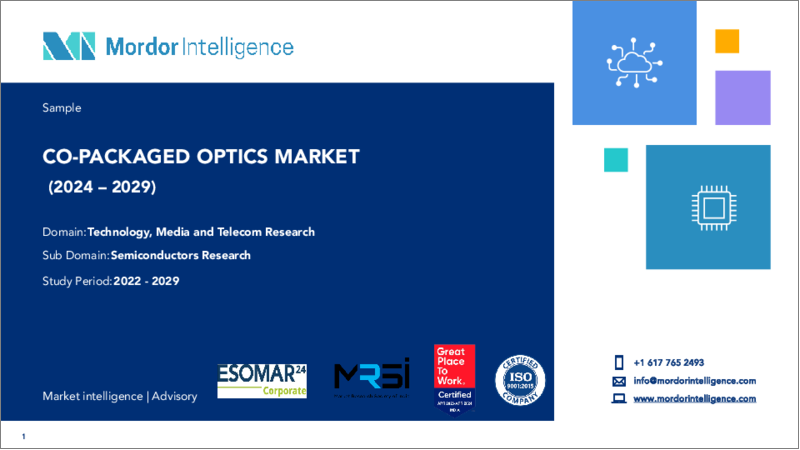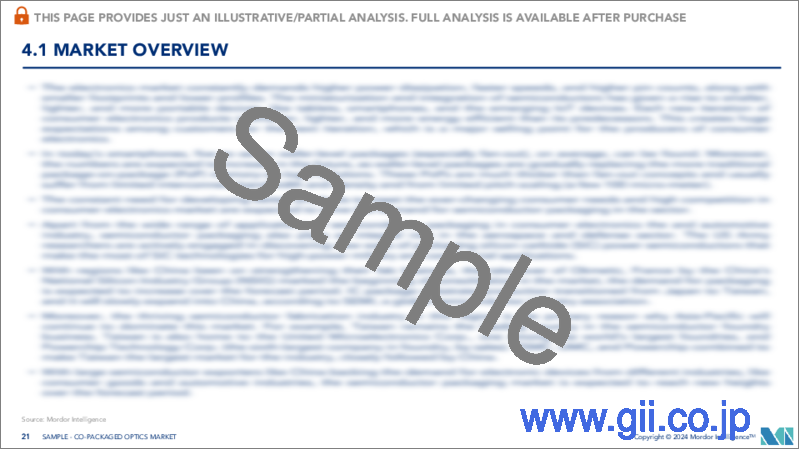|
|
市場調査レポート
商品コード
1549798
CPO(Co-packaged Optics)の世界市場:市場シェア分析、産業動向・統計、成長予測(2024年~2029年)Co-packaged Optics - Market Share Analysis, Industry Trends & Statistics, Growth Forecasts (2024 - 2029) |
||||||
カスタマイズ可能
適宜更新あり
|
|||||||
| CPO(Co-packaged Optics)の世界市場:市場シェア分析、産業動向・統計、成長予測(2024年~2029年) |
|
出版日: 2024年09月02日
発行: Mordor Intelligence
ページ情報: 英文 120 Pages
納期: 2~3営業日
|
全表示
- 概要
- 目次
世界のCPO(Co-packaged Optics)の市場規模は、2024年に7,020万米ドルと推定され、2029年には4億8,377万米ドルに達し、予測期間中(2024年~2029年)にCAGR47.12%で成長すると予測されています。

主なハイライト
- CPO(Co-packaged Optics)市場は、高速データ伝送需要の加速、データセンタやクラウドサービスの急成長で急拡大しています。CPOは、光コンポーネントと電子コンポーネントを1つのパッケージに統合することで、電気信号の移動距離を短縮し、遅延と消費電力を最小限に抑えます。これにより、従来の銅線相互接続の帯域幅の制限に対応し、次世代データセンターアーキテクチャの増大する要件を満たすことができます。
- さらに、データセンターネットワーキングにおける400G、800G、そしてそれ以上へのシフトが進行していることも、CPO(Co-packaged Optics)市場を推進する重要な要因となっています。これらの高速規格では、シグナルインテグリティやエネルギー効率の改善など、CPOが提供できるイノベーションが必要となります。データセンタは、より高速で効率的なデータ処理や伝送機能を必要としており、CPO技術はこうしたデータセンターのスケーリングニーズをサポートすることができます。
- CPO(Co-packaged Optics)市場は、フォトニクスと半導体製造の業界リーダー間のコラボレーションから恩恵を受けています。インテル、シスコ、ブロードコムなどの企業は、CPOの研究開発に多額の投資を行っています。こうしたコラボレーションは、技術の進歩、コスト削減、異なるプラットフォーム間での相互運用性の確保に不可欠です。
- CPOの採用は、これらのソリューションの互換性と信頼性を保証する業界標準と規制の枠組みの開発によって支えられています。電気電子学会(IEEE)や光インターネットワーキングフォーラム(OIF)などの標準化団体は、CPO技術の幅広い展開を促進するガイドラインの確立に取り組んでいます。
CPO(Co-packaged Optics)市場動向
高性能コンピューティングの成長
- ハイパフォーマンスコンピューティング(HPC)は、データセンター、複雑なシミュレーション、大規模データ処理、高度な科学研究に対する需要の増加により急速に成長しています。この成長は、プロセッサ、メモリ、その他の重要なコンポーネントを1つのパッケージに統合したコ・パッケージ・コンピューティングCPC(Co-packaged Computing)の動向と発展を大きく後押ししています。HPCアプリケーションはしばしば大規模なデータ処理能力を必要とし、従来の個別チップ間の相互接続がボトルネックになることがあります。CPCは、コンポーネントを密接に統合し、レイテンシを低減し、HPCワークロードに不可欠なデータスループットを向上させることで、この問題に対処します。
- コンピューティングエレメントを一緒にパッケージ化することで、CPCはパフォーマンスと効率を高めます。この統合により、データの移動距離が短縮されるため、エネルギー消費が削減され、全体的なパフォーマンスが向上します。これは、高出力で動作し、最適なエネルギー利用が求められるHPCシステムにとって極めて重要です。CPCは、より効率的なサーマルソリューションを可能にすることで、これを管理するのに役立ちます。コンポーネントが近接してパッケージ化されているため、より優れた放熱戦略をHPC環境に特化して調整することができます。
- スケーラビリティはHPCシステムにとってもう一つの重要な要素であり、増加する計算負荷に対応する能力が求められます。CPCは、従来のマルチチップセットアップに伴う複雑さを伴わずに処理能力を追加できるモジュール式アプローチを提供します。このモジュール性は、HPCインフラのスケーラブルな性質をサポートします。さらに、HPCのニーズに後押しされた半導体製造の進歩は、CPCをより現実的でコスト効率の高いものにしています。HPCの厳しい性能および統合要件を満たすために、3Dスタッキングや高度な相互接続などの技術が開発されており、CPCの採用をさらに後押ししています。
- プロセッサとメモリ間の通信オーバーヘッドを削減することは、HPCで高性能を維持するために極めて重要です。CPCは、これらのコンポーネントを単一のパッケージ内に統合することでこのオーバーヘッドを大幅に削減し、より高速で効率的なデータ交換を可能にします。当初は高価でしたが、HPC需要によるスケールメリットにより、CPCテクノロジーに関連するコストは低下しています。HPCが成長するにつれて、より大きなボリュームと継続的な進歩がコスト削減に貢献し、CPCをより身近で普及したものにしています。
アジア太平洋が大きな市場シェアを占める見込み
- アジア太平洋のCPO(Co-packaged Optics)市場は、データセンター、通信、ハイパフォーマンスコンピューティング分野の急速な進歩によって大きな成長を遂げています。
- 中国、日本、韓国などの国々が最前線にあり、データトラフィックの急激な増加、より高速で効率的なデータ伝送ソリューションの需要をサポートするために次世代ネットワークインフラストラクチャに多額の投資を行っています。例えば、2023年11月、中国の主要通信事業者3社は、5Gパッケージ加入者が合計で約2,600万人純増したと報告しました。これにより、5Gパッケージ加入者総数は約13億4,800万人に達しました。11月末までに、5Gパッケージ加入者は中国移動通信(チャイナ・モバイル)と中国電信(チャイナ・テレコム)のモバイル総加入者数のそれぞれ78.6%と77.3%を占めました。
- この地域の強力な製造基盤は、政府の支援政策や大規模なR&D投資と相まって、CPO技術のイノベーションを促進しています。さらに、アジア太平洋には大手ハイテク企業や半導体メーカーが進出しており、こうした先進的光ソリューションの採用と開発が加速しています。
- この市場の成長は、5Gネットワーク導入の増加、クラウドサービスの拡大、AIやIoTアプリケーションの継続的進化によってさらに促進され、アジア太平洋は世界のCPO(Co-packaged Optics)ランドスケープで重要なプレーヤーとして位置付けられています。エリクソンによると、5Gは2028年末までに東南アジアとオセアニアで約6億2,000万件の加入数に達すると予測されています。
CPO(Co-packaged Optics)産業概要
世界のCPO(Co-packaged Optics)市場は、いくつかの重要な企業の存在で非常に断片化されています。市場シェアでは、現在大手企業が市場を独占しています。市場で突出したシェアを持つこれらの大手企業は、世界中の顧客ベース拡大に注力しています。これらの企業は、戦略的協業イニシアチブを活用して市場シェアと収益性を高めています。
- 2024年3月:2024年光ファイバ通信会議(OFC)で、AI/MLインフラ向け先進フォトニクス相互接続ソリューション開発のリーディングカンパニーであるラノバスは、メディアテックとの協業により、メディアテックの次世代ASIC設計プラットフォーム向けに6.4TbpsCPO(Co-packaged Optics)ソリューションを提供すると発表しました。このソリューションは、AI/ML SoCおよびイーサネットアプリケーション向けに6.4Tbps高radix光インターコネクトをサポートするように設計されています。
- 2023年3月:シスコは、CPO(Co-packaged Optics)のビジョンを発表し、実現可能性だけでなく、その必要性と導入の課題を克服する戦略を示しました。
その他の特典:
- エクセル形式の市場予測(ME)シート
- 3ヶ月間のアナリストサポート
目次
第1章 イントロダクション
- 調査の前提条件と市場定義
- 調査範囲
第2章 調査手法
第3章 エグゼクティブサマリー
第4章 市場洞察
- 市場概要
- 産業バリューチェーン分析
- 業界の魅力度-ポーターのファイブフォース分析
- 新規参入業者の脅威
- 買い手の交渉力
- 供給企業の交渉力
- 代替品の脅威
- 競争企業間の敵対関係の強さ
- COVID-19の業界への影響評価
- 遅延に敏感なトラフィックがCPO需要に与える影響
- データセンターにおけるAIと機械学習
- 5G、CPO、データセンターへの影響
- ビデオ会議とオンラインイベント
第5章 市場力学
- 市場促進要因
- スマートデバイスの普及とデータトラフィックの増加
- メガデータセンターの重要性の高まり
- 高性能コンピューティングの成長
- 市場抑制要因
- ネットワークの複雑化
- デバイスの互換性と持続可能性の問題
第6章 市場セグメンテーション
- データレート別
- 1.6T未満
- 1.6T
- 3.2T
- 6.4T
- 地域別
- 北米
- 欧州
- アジア
- オーストラリア・ニュージーランド
- ラテンアメリカ
- 中東・アフリカ
第7章 競合情勢
- 企業プロファイル
- Ayar Labs Inc.
- Broadcom Inc.
- Cisco Systems Inc.
- IBM Corporation
- Intel Corporation
- Microsoft Corporation
- TE Connectivity
- Furukawa Electric Co. Ltd
- Hisense Broadband Multimedia Technology Co. Ltd
- POET Technologies
- Kyocera Corporation
- Huawei Technologies Co. Ltd
- SENKO Advanced Components Inc.
- Sumitomo Electric Industries Ltd
第8章 投資分析
第9章 市場の将来展望
The Co-packaged Optics Market size is estimated at USD 70.20 million in 2024, and is expected to reach USD 483.77 million by 2029, growing at a CAGR of 47.12% during the forecast period (2024-2029).

Key Highlights
- The co-packaged optics (CPO) market is growing rapidly due to the accelerating demand for high-speed data transmission and the exponential growth of data centers and cloud services. Co-packaged optics integrate optical and electronic components into a single package, reducing the distance that electrical signals need to travel and minimizing latency and power consumption. This addresses the bandwidth limitations of traditional copper interconnects and meets the growing requirements of next-generation data center architectures.
- Moreover, the ongoing shift toward 400 G, 800 G, and beyond in data center networking is a key factor propelling the co-packaged optics market. These higher-speed standards require innovations that CPOs can deliver, such as improved signal integrity and energy efficiency. Data centers require faster, more efficient data processing and transmission capabilities, and CPO technology can support the scaling needs of these data centers.
- The co-packaged optics market is benefiting from collaborations between industry leaders in photonics and semiconductor manufacturing. Companies such as Intel, Cisco, and Broadcom are investing heavily in CPO research and development. These collaborations are essential for advancing the technology, reducing costs, and ensuring interoperability across different platforms.
- The adoption of co-packaged optics is supported by the development of industry standards and regulatory frameworks that ensure the compatibility and reliability of these solutions. Standards associations, including the Institute of Electrical and Electronics Engineers (IEEE) and the Optical Internetworking Forum (OIF), are working to establish guidelines that facilitate the broader deployment of CPO technology.
Co-packaged Optics Market Trends
Growth in High-performance Computing
- High-performance computing (HPC) is rapidly growing due to increasing demands for data centers, complex simulations, large-scale data processing, and advanced scientific research. This growth significantly drives the trend and development in co-packaged computing (CPC), where processors, memory, or other critical components are integrated into a single package. HPC applications often require massive data processing capabilities, and traditional interconnects between separate chips can become bottlenecks. CPC addresses this by integrating components closely, reducing latency, and increasing data throughput, which is essential for HPC workloads.
- By packaging computing elements together, CPC enhances performance and efficiency. This integration reduces the distance data needs to travel, cutting energy consumption and improving overall performance, which is crucial for HPC systems that operate at high power and require optimal energy utilization. High-performance computations generate significant heat, and CPC helps manage this by allowing for more efficient thermal solutions. Since components are packaged in proximity, better heat dissipation strategies can be tailored specifically for HPC environments.
- Scalability is another critical factor for HPC systems, which demand the ability to handle increasing computational loads. CPC offers a modular approach where additional processing power can be added without the complexities associated with traditional multi-chip setups. This modularity supports the scalable nature of HPC infrastructures. Moreover, advances in semiconductor fabrication, driven by the needs of HPC, are making CPC more viable and cost-effective. Techniques like 3D stacking and advanced interconnects are being developed to meet the stringent performance and integration requirements of HPC, further propelling the adoption of CPC.
- Reducing communication overhead between processors and memory is crucial for maintaining high performance in HPC. CPC significantly reduces this overhead by integrating these components within a single package, enabling faster and more efficient data exchanges. While initially expensive, the economies of scale driven by HPC demand are reducing the costs associated with CPC technologies. As HPC grows, the larger volumes and continuous advancements help reduce costs, making CPC more accessible and widespread.
Asia-Pacific is Expected to Hold Significant Market Share
- The co-packaged optics market in Asia-Pacific is experiencing significant growth, driven by rapid advancements in data centers, telecommunications, and high-performance computing sectors.
- Countries like China, Japan, and South Korea are at the forefront, investing heavily in next-generation network infrastructure to support the exponential increase in data traffic and the demand for faster, more efficient data transmission solutions. For instance, in November 2023, China's three main telecom operators reported a combined net increase of around 26 million 5G package subscribers. This brought their total 5G package subscriber base to nearly 1.348 billion. By the end of November, 5G package subscribers made up 78.6% and 77.3% of China Mobile's and China Telecom's total mobile subscriber bases, respectively.
- The region's strong manufacturing base, coupled with supportive government policies and substantial R&D investments, is fostering innovation in co-packaged optics technology. Additionally, the presence of major tech companies and semiconductor manufacturers in Asia-Pacific is accelerating the adoption and development of these advanced optical solutions.
- This market's growth is further propelled by the increasing implementation of 5G networks, the expansion of cloud services, and the continuous evolution of AI and IoT applications, positioning Asia-Pacific as a critical player in the global co-packaged optics landscape. According to Ericsson, 5G is projected to reach approximately 620 million subscriptions in Southeast Asia and Oceania by the end of 2028.
Co-packaged Optics Industry Overview
The global co-packaged optics market is highly fragmented due to several significant players. In terms of market share, the major players currently dominate the market. These major players with prominent shares in the market are focusing on expanding their customer base worldwide. These companies leverage strategic collaborative initiatives to increase their market shares and profitability.
- March 2024: At the 2024 Optical Fiber Communication Conference (OFC), Ranovus, a leading developer of advanced photonics interconnect solutions for AI/ML infrastructure, announced its collaboration with MediaTek to deliver a 6.4 Tbps co-packaged optics solution for MediaTek's next-generation ASIC design platform. This solution is designed to support a 6.4 Tbps high-radix optical interconnect for AI/ML SoC and ethernet applications.
- March 2023: Cisco presented its vision for co-packaged optics, demonstrating not only their feasibility but also the necessity for them and the strategies to overcome deployment challenges.
Additional Benefits:
- The market estimate (ME) sheet in Excel format
- 3 months of analyst support
TABLE OF CONTENTS
1 INTRODUCTION
- 1.1 Study Assumption and Market Definition
- 1.2 Scope of the Study
2 RESEARCH METHODOLOGY
3 EXECUTIVE SUMMARY
4 MARKET INSIGHTS
- 4.1 Market Overview
- 4.2 Industry Value Chain Analysis
- 4.3 Industry Attractiveness - Porter's Five Forces Analysis
- 4.3.1 Threat of New Entrants
- 4.3.2 Bargaining Power of Buyers
- 4.3.3 Bargaining Power of Suppliers
- 4.3.4 Threat of Substitute Products
- 4.3.5 Intensity of Competitive Rivalry
- 4.4 Assessment of Impact of COVID-19 on the Industry
- 4.5 Impact of Latency-Sensitive Traffic on Demand for CPO
- 4.5.1 AI and Machine Learning in Data Centers
- 4.5.2 5G, CPO, and the Impact on Data Centers
- 4.5.3 Video Conferencing and Online Events
5 MARKET DYNAMICS
- 5.1 Market Drivers
- 5.1.1 Increase in Adoption of Smart Devices and Rise in Data Traffic
- 5.1.2 Growth in the Importance of Mega Data Centers
- 5.1.3 Growth in High-performance Computing
- 5.2 Market Restraints
- 5.2.1 Increase in Network Complexity
- 5.2.2 Device Compatibility and Sustainability Issues
6 MARKET SEGMENTATION
- 6.1 By Data Rates
- 6.1.1 Less than 1.6 T
- 6.1.2 1.6 T
- 6.1.3 3.2 T
- 6.1.4 6.4 T
- 6.2 By Geography
- 6.2.1 North America
- 6.2.2 Europe
- 6.2.3 Asia
- 6.2.4 Australia and New Zealand
- 6.2.5 Latin America
- 6.2.6 Middle East and Africa
7 COMPETITIVE LANDSCAPE
- 7.1 Company Profiles
- 7.1.1 Ayar Labs Inc.
- 7.1.2 Broadcom Inc.
- 7.1.3 Cisco Systems Inc.
- 7.1.4 IBM Corporation
- 7.1.5 Intel Corporation
- 7.1.6 Microsoft Corporation
- 7.1.7 TE Connectivity
- 7.1.8 Furukawa Electric Co. Ltd
- 7.1.9 Hisense Broadband Multimedia Technology Co. Ltd
- 7.1.10 POET Technologies
- 7.1.11 Kyocera Corporation
- 7.1.12 Huawei Technologies Co. Ltd
- 7.1.13 SENKO Advanced Components Inc.
- 7.1.14 Sumitomo Electric Industries Ltd






